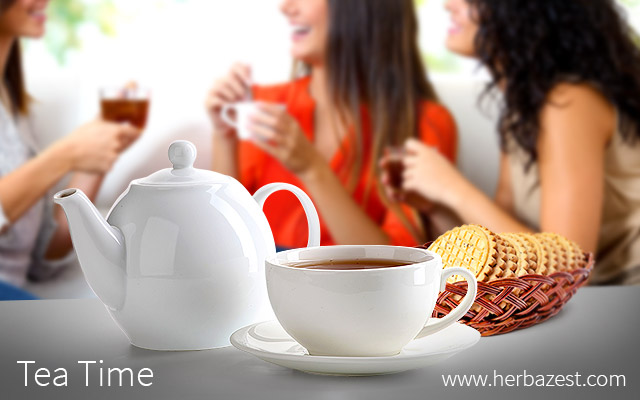Most people associate tea time with the British tradition of drinking tea in the afternoon. Although this ritual has changed significantly in the modern times tea continues to be an important aspect of the social identity, with about 160 million cups of tea consumed daily in Great Britain. Tea time tradition is so important for the Britons that, in an effort to protect and prolong its practice, an official Afternoon Tea Week has been invented and it is celebrated every year in August.
The Origin of Tea Time
The leaves of the tea plant (Camellia sinensis) were introduced into England from China in the 1650s, but tea consumption was initially limited to the richest, who could afford drinking this pricey, newly imported beverage in elegant coffee shops. Over the last 200 years, the prices of tea leaves, including teabags and loose leaf tea, as well as most popular tea varieties and a myriad of tea blends, have gradually decreased and nowadays they are affordable to all people, despite their economic status
By the 1840s, the afternoon ritual of drinking tea was popularized by the Duchess of Bedford, who reportedly became too hungry to wait for the evening meal and tea and requested it to be served around four o'clock in the afternoon. This gave rise to the new social practice across the Great Britain. Women started meeting for afternoon tea, a leisure time when they could share their gossips and converse in private. By the 19th century, tea became an inseparable part of British identity.
Modern Day Tea Time
The concept of tea time has changed over the years, and it now varies across the country. For most Britons, it refers to a snack eaten during the day, which is also a 20-minute work break granted by the law. The elevenses is a small meal taken around eleven in the morning, which consists of hot tea, coffee, or any other beverage with a muffin, scone, or a biscuit. The afternoon tea, also called low tea, is consumed around three or four o'clock, and it is also accompanied by a snack of some sort. High tea was traditionally a larger meal eaten by the working class, who could not take tea time breaks throughout the day, and therefore, had their tea late at night. Nowadays, high tea is how most Britons call dinner, eaten between six and eight in the evening.
Tea Time Etiquette
During the 18th and 19th centuries, tea time gatherings were governed by a set of strict rules, and tea was served in beautiful porcelain, bone china, or silver ware. Ignorance of the tea etiquette was considered a faux pas and often resulted in social rejection of the offender.
The rules dictated that the napkin should always be placed on the lap and the milk should be added after the tea to ensure the right tea strength. The cup should rest on the middle finger, slightly held by the thumb and index finger. The little finger should never stick out, instead it should be rolled in a fist. Tea should be stirred in a back and forth motion, as opposed to a circular one. Sandwiches, scones, and biscuits must be eaten by hand without any utensils, while cakes can be eaten with a fork.
Tea etiquette go even that far to say that if a scone is cut in half and smeared with strawberry jam, the halves should never be put back together.
Tea Time Around the World
Although not as popular as in the United Kingdom, tea time is an important tradition of mid-day snacking in other countries around the world as well, often without drinking tea. In Chile and Colombia, the term la once originally referred to an eleven o'clock tea, but now it indicates having tea or coffee with a small snack, like crackers or cookies, later on in the afternoon, between five and seven. In Australia, New Zealand, Hungary, Spain, and Israel tea time signifies a snack, eaten between breakfast and lunch.
Sources
- A Social History of Tea: Tea's Influence on Commerce, Culture & Community
- Food and Cooking in Victorian England: A History
- Tea Time Entertaining: A Collection of Tea Themes & Recipes
- The True History of Tea




